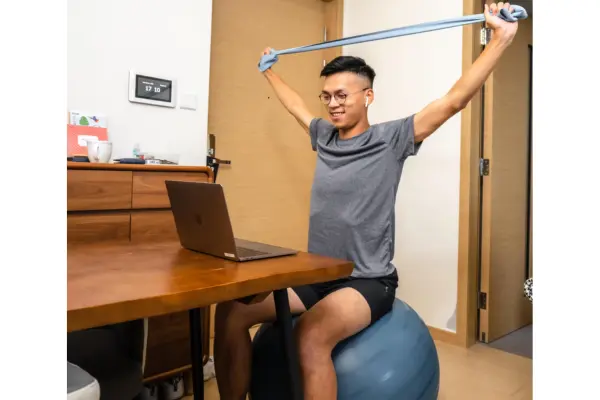Table of Contents
Practical Tips for a Productive Work-from-Home Routine: Remote work in 2025 has become the new norm, offering flexibility and freedom. However, maintaining a productive and joyful Work from Home Routine can be challenging due to distractions, lack of structure, and isolation. Without an efficient system, staying focused and achieving work-life balance feels overwhelming. That’s why creating an optimized routine is crucial for success. In this guide, we reveal 7 game-changing hacks to help you stay productive, energized, and stress-free. From designing a distraction-free workspace to mastering time management and staying socially connected, these proven strategies will transform your remote work experience and boost your efficiency.
Hack #1: Design a Distraction-Free Workspace 🚀
Why a Dedicated Workspace Matters
Imagine trying to focus on an important project while sitting on your bed—you’ll likely feel sleepy or unmotivated. Having a designated workspace significantly boosts focus, motivation, and efficiency.
A well-structured home office:
✅ Reduces distractions and improves focus.
✅ Creates a work-mindset shift, increasing motivation.
✅ Prevents body strain, leading to better posture and health.
Practical Tips for a Productive Work-from-Home Routine -Boosting Home Office
1. Choose the Right Spot at Home
- Pick a quiet and well-lit area, away from TV and family noise.
- If possible, face a window for natural light (proven to boost mood and energy).
2. Invest in Ergonomic Furniture
- Standing desk: Helps maintain posture and prevents back pain.
- Ergonomic chair: Supports your spine and reduces discomfort.
- Wrist support keyboard & mouse: Reduces strain on hands and wrists.
3. Block Out Noise & Distractions
- Use noise-canceling headphones (Bose, Sony, or AirPods Pro).
- Try white noise apps like Noisli or Brain.fm.
- Set “Do Not Disturb” hours to minimize interruptions.
4. Declutter & Organize Your Space
A messy workspace = a messy mind.
- Use shelves & storage boxes to keep your desk clean.
- Keep only essentials like a laptop, notebook, and coffee.
- Add personal touches (plants, motivational quotes) for inspiration.
💡 Real-Life Example: From Chaos to Productivity
Sarah, a remote marketing manager, struggled with distractions at home. She redesigned her workspace using a minimalist desk, a comfortable chair, and a noise-blocking setup. Within a month, she reported a 40% increase in productivity and better work-life balance.
Takeaway: Invest in your workspace—your productivity depends on it!
Hack #2: Master the Power of Time Blocking ⏳
What is Time Blocking & Why Does it Work?
Time blocking is a productivity technique where you divide your day into focused work sessions, eliminating multitasking.
📌 Why it works:
✅ Helps you prioritize tasks effectively.
✅ Prevents burnout by ensuring breaks.
✅ Increases focus by reducing distractions.
How to Divide Your Workday for Maximum Efficiency
Follow these steps to implement time blocking:
1️⃣ Identify High-Priority Tasks – List top 3 tasks for the day.
2️⃣ Set Work Blocks (Deep Work Sessions) – Example:
- 9:00 AM – 11:00 AM – Focused writing session
- 11:15 AM – 12:30 PM – Email & communication
- 2:00 PM – 4:00 PM – Meetings & project reviews
3️⃣ Use Break Blocks – 15-minute breaks every 90 minutes.
Best Tools for Time Blocking
🗓 Google Calendar – Schedule tasks with reminders.
📋 Trello/Notion – Organize projects & track progress.
⏳ Pomodoro Technique (25/5 Rule) – Work 25 min, rest 5 min.
Pro Tip: The 90-30 Rule for Maximum Productivity
📢 Work in 90-minute sessions, followed by a 30-minute break.
💡 This technique aligns with the brain’s natural focus rhythm, boosting efficiency.
Hack #3: Establish a Morning Routine That Sets the Tone ☀️
Why Morning Rituals Are Crucial for Remote Workers
A structured morning routine prepares your mind and body for a productive day.
Key Elements of a Powerful Morning Routine
| Activity | Benefits |
|---|---|
| Exercise & Stretching | Boosts energy and improves posture. |
| Meditation or Journaling | Enhances focus and reduces stress. |
| Healthy Breakfast & Hydration | Fuels the brain for optimal performance. |
| Setting Goals for the Day | Provides direction and increases motivation. |
Example: Productive vs. Non-Productive Morning Routine
| Productive Morning | Non-Productive Morning |
|---|---|
| Wake up early (6-7 AM) | Wake up late (9-10 AM) |
| 10-15 min exercise | Check phone immediately |
| Healthy breakfast | Skip breakfast / coffee-only |
| Set daily priorities | Start work without a plan |
💡 Pro Tip: Avoid checking your phone in the first hour of waking up—it prevents distraction overload!
Hack #4: Optimize Your Digital Work Environment 🖥️
How Digital Clutter Impacts Productivity
A messy digital workspace = constant distractions. If your desktop looks like a chaotic jungle of files, it’s time to clean up!
📌 Problems Caused by Digital Clutter:
❌ Wasted time searching for files.
❌ Constant email notifications disrupting focus.
❌ Overloaded browser tabs slowing productivity.
Best Practices for Managing Digital Workflows
✅ Keep a Clean Desktop – Organize files into folders.
✅ Use Automation Tools – Set up email filters for quick sorting.
✅ Schedule Digital Detox – Close unused tabs & apps daily.
Essential Productivity Apps & Tools
| Tool | Purpose |
|---|---|
| Notion | Task & project management |
| Slack | Team communication |
| Focus@Will | Music for deep focus |
| RescueTime | Tracks time spent on tasks |
💡 Pro Tip: Use “Do Not Disturb” mode on your devices during deep work sessions.
Hack #5: Incorporate Movement and Breaks into Your Day 🏃♂️💨
The Dangers of Sitting Too Long
Did you know that prolonged sitting increases the risk of back pain, fatigue, poor posture, and even chronic health issues like heart disease? Many remote workers unknowingly fall into the trap of working for hours without moving, leading to burnout and decreased productivity.
How Micro-Breaks Improve Focus and Prevent Burnout
Studies show that short, frequent breaks enhance cognitive function and overall well-being. Regular movement helps reduce eye strain, prevent stiffness, and boost energy levels, keeping you sharp throughout the day.
Techniques to Stay Active While Working from Home
Here are simple yet effective ways to incorporate movement into your Work from Home Routine:
🔹 The 20-20-20 Rule – Every 20 minutes, look at something 20 feet away for 20 seconds to prevent eye strain.
🔹 Standing Meetings & Walking Calls – Take client calls while standing or walking around to keep your body engaged.
🔹 Desk Exercises & Stretches – Simple neck rolls, wrist stretches, and seated leg raises improve circulation and posture.
🔹 Use a Standing Desk – Alternating between sitting and standing improves energy levels and reduces back pain.
Case Study: How Movement Transformed a Work-from-Home Employee’s Health
Meet Jake, a graphic designer who suffered from chronic back pain and low energy. By incorporating standing meetings, hourly desk stretches, and short walks, he noticed a 50% reduction in back pain and increased focus throughout the day.
💡 Takeaway: Schedule movement breaks just like meetings—your body will thank you!

Hack #6: Set Clear Boundaries Between Work and Personal Life ⏳🏠
The Problem of Overworking from Home
When your office is just a few steps away, it’s easy to keep working late, check emails after hours, or blur the lines between work and relaxation. This leads to mental exhaustion, decreased productivity, and burnout.
Tips for Maintaining Work-Life Balance
✅ Set a Hard Stop Time for Work – Choose a specific time to end your workday and stick to it.
✅ Use a Separate Phone Number for Work – Keep a work-only phone number or app to disconnect easily after hours.
✅ Create End-of-Day Rituals – Signal the end of work by taking a walk, changing clothes, or journaling.
✅ Communicate Boundaries to Family & Colleagues – Let others know your working hours to minimize interruptions.
Real-World Insights: How Remote Workers Set Boundaries
📌 Emma, a remote consultant, struggled with overworking until she started setting a “shutdown alarm” at 6 PM. This helped her step away from her desk, spend quality time with family, and sleep better.
📌 Michael, a freelance writer, switched to a co-working space twice a week to separate work and personal life, which improved his focus and mental health.
💡 Takeaway: Setting clear boundaries is the key to sustaining long-term productivity and well-being.

Hack #7: Stay Social and Connected 🤝💬
The Risk of Isolation While Working from Home
One of the biggest downsides of remote work is loneliness and lack of social interaction. Humans are social beings, and without daily office interactions, motivation and creativity can decline.
How to Maintain Social Interactions While Working from Home
Here’s how you can stay connected and engaged:
🔹 Virtual Coffee Breaks with Colleagues – Schedule casual 15-minute catch-ups to stay in touch with your team.
🔹 Join Networking Groups & Online Communities – Platforms like Slack groups, LinkedIn, and Facebook communities provide valuable discussions and support.
🔹 Try Co-Working Spaces or Hybrid Work Models – Working in a shared office once or twice a week reduces isolation and boosts productivity.
Case Study: How a Freelancer Overcame Loneliness with Online Work Groups
Meet Sophia, a remote content writer who felt disconnected from peers. She joined an online mastermind group where professionals shared ideas and motivation. Within a few months, she felt more engaged, built strong connections, and improved her work satisfaction.
💡 Takeaway: Social interactions fuel creativity and happiness—make it a priority.

A well-structured Work from Home Routine can revolutionize your productivity and overall well-being. By implementing these 7 hacks, you’ll create a balanced, efficient, and joyful work-life experience. Whether it’s setting boundaries, optimizing your workspace, or staying active, these simple changes can make a massive impact. Now it’s your turn—try these hacks today and share your experience! Do you have a favorite work-from-home tip? Drop it in the comments! 🚀
How can I improve my focus while working from home?
To improve focus, use techniques like time blocking, Pomodoro method, and digital detoxing. Reduce distractions with a structured schedule and productivity apps like Notion.
What are the best tools for remote collaboration?
Top tools include Slack for communication, Asana for task management, and Zoom for virtual meetings. These platforms help teams stay connected and organized.
How do I prevent burnout while working remotely?
Maintain work-life balance by setting clear boundaries, taking regular breaks, and practicing self-care activities like meditation or exercise.
What is the best way to set up a home office for productivity?
Choose a quiet workspace, invest in an ergonomic chair and desk, use noise-canceling headphones, and keep your area clutter-free for maximum efficiency.
Read this also “Jio Coin Price Prediction: How Much Will Reliance’s New Cryptocurrency Be Worth in 2025? How To Buy It?”
” Daily 100 Rupees Earning App: 5 Powerful Ways to Earn ₹1000/Day Without Investment!“
“Earn Money from Online Craft Tutorials: 9 Creative Tips to Sell Your DIY Expertise!”
“How to Work from Home Without Burnout: 5 Breakthrough Tips for Stress-Free Productivity“


![[Free] 21 Best AI Tools for Engineering Students: No Login Required + Genius Hacks! AI Tools for Engineering Students](https://rashatimes.com/wp-content/uploads/2025/02/AI-Tools-for-Engineering-Students-150x150.webp)




1 thought on “7 Practical Tips for a Productive Work-from-Home Routine!”